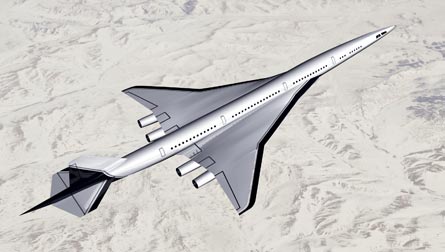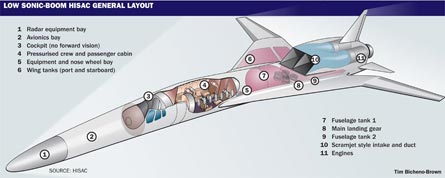In 2005 it seemed Europe and the USA were racing to bring to market a supersonic business jet that could fly from one to the other in half the time taken by subsonic airlines. Five years on, how distant is a booming market for faster-than-sound aircraft?
Back then US industry was testing designs in windtunnels and NASA had been working with the 10-company Supersonic Cruise Industry Alliance on a low-boom flight demonstration study.
That same year, from May, the European Union began funding its €26 million ($35.2 million) Environmentally Friendly High Speed Aircraft, or HISAC, project that had the same ultimate goal - to discover how to create a business jet that could halve transatlantic flight times and be environmentally friendly.
|
|---|
Led by Dassault Aviation, the European project was created because studies found that there is a demand for current subsonic business aircraft flight times to be reduced by up to 50%. The notional date for such an aircraft was 2015. Compared with the supersonic alliance's effort it had a wider set of environmental objectives. The HISAC goals were to achieve ICAO Chapter 3 levels of community noise, keeping nitrogen oxide emissions to less than 5g per kilogramme (0.18oz/2.2lb) of fuel burnt, having landing and take-off emissions comparable with subsonic aircraft and mitigating the overland sonic boom.
After five years of work, the final HISAC report found that the Sukhoi Civil Aircraft-led Russian team had produced a design that met the environmental objectives. For HISAC three teams evolved classes of concepts that examined different aspects of the technical challenges facing a supersonic business jet. Team C was led by Sukhoi, working with the Central Aerohydrodynamics Institute and Central Institute of Aviation Motors (CIAM), and the others were Dassault's team A and Alenia Aeronautica's B.
LOW SONIC BOOM
Sukhoi's C team focused on the low sonic boom concept. Dassault's team examined configuration A, a low noise design with a delta wing, and a "high subsonic" concept called D1. The D1 could dash at Mach 1.2.
Team B had Alenia's B1 long-range laminar wing concept and a variable geometry design called B2. The B2 was studied by Alenia's team B partner Aircraft Development and Systems Engineering (ADSE), which also examined the D2, a "low supersonic" aircraft that had a cruise speed of M1.2, not the required M1.8.
The M1.8 speed was one of several common sets of specifications abided by the classes of concepts. They were cruise speeds of M0.95 to M1.8, a top range of 7,400km (4,000nm), a cabin for eight passengers, but one that could hold 19, and a maximum sonic boom sound level for those on the ground of 65dBA.
ENVIRONMENTAL CREDENTIALS
Of those six concepts HISAC's report identifies the variable geometry B2 and the high subsonic D1 as having environmental and performance characteristics approaching that of Sukhoi's design. The B2 has better performance than the D1, while it in turn has better environmental credentials.
ADSE's variable geometry concept was deemed to have good flight performance but it comes with technical and certification issues that the project's report says "may be very difficult to overcome". While the low sonic boom and high subsonic designs had good environmental characteristics within the six concepts, the report concluded that supersonic flight has a higher climate impact than subsonic.
For analysing the relative overall environmental impact of a supersonic business jet, the factors were fuel consumption, cruise altitude, cruise phase nitrogen oxide emissions, engine operating temperature, landing and take-off phases. Instead of being more environmentally friendly than conventional flight the HISAC report says: "For a high-speed/supersonic fleet, the goal is to obtain standards of the same quantities as those of subsonic aircraft, and to remain within close limits to them."
The technological advances for efficient high-speed flight, in matters of engine improvement, combustion efficiency, optimised airframe and flightpath considerations "lead to plausible trade-offs to remain environmentally friendly".
To reach these conclusions about the concepts HISAC's partners research encompassed four areas that could be broadly described as noise, including sonic boom mitigation, aerodynamics, more efficient lift and engines - from their contribution to drag to the powerplant's cycle.
HISAC's focus on drag was such that one of the six concepts had a laminar wing. To achieve laminar flow, Germany's DLR aerospace agency examined surface roughness as a source of improved airflow. Suction systems to stop boundary layer separation were also been examined for the project.
Positioned at the leading edge of the wing the active system would require 40hp (30kW) of power and have a mass of 130kg (286lb). The work found that a significant region of laminar flow can be achieved, mostly on the outboard wing using suction and cooling techniques. The cooling involves a cryogenic liquid nitrogen system to cool an area of the surface from the leading edge towards the wing's centre.
It was in June 2007 that HISAC's first high-speed windtunnel test campaign took place at French aerospace agency ONERA's S2 facility in Modane in southern France. That work examined the impact of control surface and engine integration options on drag. The aerodynamic work also examined the addition of a spike device to the front of the aircraft for sonic boom mitigation.
Without such a spike, Sukhoi's low-boom sonic boom concept was found to be 20dB less than a conventional non-low-boom configuration. Before the windtunnel work, the advantages of the Sukhoi design were recognised in 2006 when Alenia Aeronautica announced its intention to discuss developing an SSBJ with the Russian company.
LOW MATURITY
Despite the Sukhoi's advantages overall, HISAC's report says the maturity of the specific technologies identified for all the concepts "is rather low". Technology roadmaps have been proposed for engines and aircraft and they include low emission combustors, more electric systems, high lift devices and anti-icing.
In November 2004 Aerion and Supersonic Alliance International announced at the NBAA business aviation convention their intention to develop a SSBJ. Six years on, are prospects good for meeting the HiSAC timeframe of a supersonic business jet in another five years? Not according to the project's executive summary, which ends: "The maturation of the required technologies and of the new international standards is a long-term process".
GREEN SUPERSONIC OBJECTIVES
Starting in May 2005 and ending in February this year, the €26 million ($35.2 million) Environmentally Friendly High-Speed Aircraft (HiSAC) project's goal was to create technical specifications for an economically viable green supersonic business jet.
Led by Dassault Aviation, the specifications produced by this European Union Sixth Framework Programme effort were to achieve a number of objectives. They included how to reduce noise by 8dB, keeping nitrogen oxide emissions to less than 5g per kilogramme (0.18oz/2.2lb) of fuel burnt, having landing and take-off emissions comparable with subsonic aircraft and mitigating the overland sonic boom.
All this was to be possible for a supersonic business jet that carried up to 16 passengers and could halve transatlantic range flight times. Roadmaps to mature the necessary technologies were also a goal. The project was created because studies found that there is a demand for current subsonic business aircraft flight times to be reduced by up to 50% on distances of more than 6,500km (3,510nm) - the minimum required for transatlantic journeys.
ALL'S STILL QUIET ON THE AERION FRONT Like actor Bill Murray in the 1993 comedy movie Groundhog Day, nascent supersonic business jet company Aerion would appear to be trapped in a "day" that keeps repeating. Since 2006, the company at practically every major trade show has been on the verge, always unrequited, of landing a major airframer to join it in building its 14-seat, Mach 1.6 twin-engined jet. And since 2008, it has been clamped at 50 orders, representing a potential revenue of $40 billion at $80 million an aircraft. At this year's EBACE business aviation conference and exhibition in Geneva, the cycle will continue. "We continue to have fruitful discussions," Aerion vice-chairman Brian Barents says. "We're not able to discuss the developments in too much detail, but we do feel that we're on a path to announce the formation of a joint venture by end of this year." In Aerion's defence, the economic climate has not been favourable for an original equipment manufacturer to take a chance on a new design. Even Aerion's chief competitor in the sector, Gulfstream, has been largely quiet on its supersonic ambitions. In Gulfstream's case, however, the hesitation to date has not been about order potential but in bringing about a rule change to allow supersonic overland flight. Aerion's design, by contrast, is efficient in subsonic as well as supersonic flight, allowing for overland flights at just below or above M1 and M1.6 supersonic oceanic cruise with no rule changes. An expected upswing on the horizon however could paint Barent's year-end optimism in a better light. "We're very encouraged based on what some others have seen in this downturn. Interest in product remains," says Barents. Although the orderbook has not grown, it has not contracted either. "There have been a couple of cancellations," he says, "but those have been replaced with new orders so that we're right about the same number." Progress on the technical front at the moment is also mired in its own Groundhog Day as a NASA Boeing F-15 needed to perform crucial in-flight laminar flow wing testing, the linchpin of Aerion's ability to deliver the promised performance, has been down for maintenance for five months with no particular completion date in sight. "We're hoping for June," says Aerion. Forthcoming phases of flight-testing will allow analysts to correlate results from earlier European transonic windtunnel tests in 2008 that demonstrated successful laminar flow, albeit for a small version of the aerofoil. To get closer to the actual performance of the aircraft, Aerion plans to test on the F-15 a 1.2m (4ft) span, 2.1m chord aerofoil section that much more closely represents the final product compared with earlier test aerofoils with half the chord. Chief technology officer Richard Tracy says that as structures and systems are coming closer to preliminary design maturity, the company is considering moving from the baseline aluminium fuselage to a carbonfibre construction, the technology selected for the wings. Despite the hurdles, Tracy says there has been progress over the past year, enough to guarantee to customers that the aircraft will perform as advertised. |
Source: Flight International

























